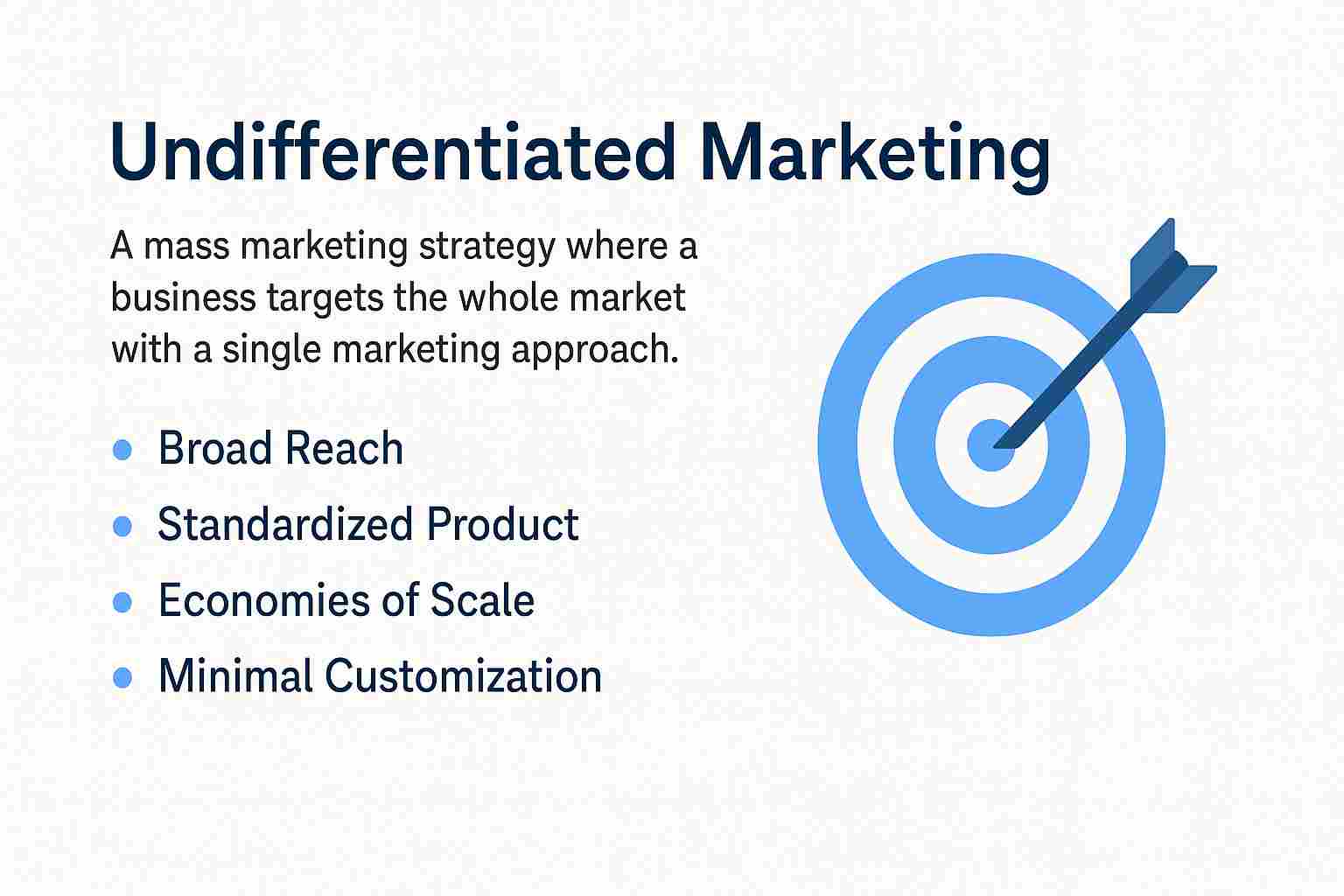In a world obsessed with personalization, undifferentiated marketing seems almost old-school — but that’s what makes it powerful. This marketing strategy focuses on mass appeal, promoting a single message or product to an entire audience, regardless of individual preferences or demographics.
What is Undifferentiated Marketing?
Undifferentiated marketing, also known as mass marketing, is a strategy where a business targets the whole market with a single marketing approach, offering the same product or service to all consumers without segmenting the audience. It assumes that the product or brand has universal appeal, solving a common need shared by the masses.
🎯 Key Characteristics:
- One marketing mix for the entire market.
- Emphasis on volume sales and brand recall.
- Often used for commodities and fast-moving consumer goods (FMCG).
Historical Context: The Origins of Mass Marketing
Undifferentiated marketing became popular during the Industrial Revolution, when mass production enabled companies to scale output quickly. With limited media channels like radio and newspapers, mass marketing was efficient and cost-effective.
Brands like P&G, Ford, and Coca-Cola pioneered mass communication by promoting standardized products to a wide audience — leveraging slogans, print ads, and radio jingles to become household names.
Even in the 21st century, its legacy lives on in global branding campaigns.
How Does Undifferentiated Marketing Work?
This approach uses one standardized marketing mix — product, price, promotion, and place (4Ps) — across the entire customer base.
Example:
- A soap brand may offer one variant, one price point, and advertise with the message: “For clean, healthy skin, every day.”
- No segmentation. No tailoring. Just reach.
Implementation Channels:
- Television and radio
- Print ads (magazines, newspapers)
- Billboards
- Social media (broad-targeted ads)
- Sponsorships (sports, events)
Advantages of Undifferentiated Marketing
1. Cost Efficiency
Producing and promoting one product with one message helps businesses reduce:
- Production costs (bulk manufacturing)
- Marketing costs (single campaign)
- Distribution costs (unified supply chain)
2. Wide Market Reach
By not narrowing the audience, brands can reach millions of potential buyers, ideal for:
- Basic necessities
- Consumer staples
- National/global brands
3. Stronger Brand Identity
A single consistent message increases brand familiarity. Repetition leads to top-of-mind awareness, especially when associated with emotions or daily life.
4. Simplified Business Operations
Without the need to manage multiple products or marketing messages, businesses can streamline their:
- Inventory
- Logistics
- Advertising strategies
Disadvantages of Undifferentiated Marketing
1. Lack of Personalization
Today’s consumers expect brands to “know them.” Ignoring personalization can:
- Reduce engagement
- Lower customer satisfaction
- Increase churn
2. High Competitive Pressure
When everyone uses a similar approach in a saturated market, differentiation becomes difficult, leading to price wars or reduced loyalty.
3. Wasted Resources
Spending on mass advertising may result in:
- Reaching irrelevant audiences
- Lower return on ad spend (ROAS)
4. Unsuitable for Specialized Products
If your offering is niche (e.g., luxury skincare or B2B software), mass marketing may not align with your target market’s expectations.
Why Does Undifferentiated Marketing Still Work?
Despite the rise of personalized experiences, human nature hasn’t changed. We still respond to emotionally charged, universal messages.
Brands that evoke feelings of happiness, security, connection, or status can cut across demographic boundaries. That’s why slogans like:
- “Just Do It” (Nike)
- “Because You’re Worth It” (L’Oréal)
- “Open Happiness” (Coca-Cola)
…still resonate worldwide.
Undifferentiated Marketing in the Digital Age
You might assume undifferentiated marketing is dead in the age of algorithms. It’s not — it has simply evolved.
Here’s how:
- YouTube pre-roll ads: One message delivered to millions
- Meta/Google Ads: Broad targeting settings with huge reach
- Influencer partnerships: Celebrities with mass appeal (e.g., Virat Kohli, Cristiano Ronaldo)
- Viral content: A single meme or video can go global instantly
Digital tools allow marketers to broadcast universal messages at scale, while platforms like AI-based ad managers handle distribution.
Real-World Examples of Undifferentiated Marketing
1. Coca-Cola
Arguably the poster child of mass marketing. From the iconic “Share a Coke” campaign to global sponsorships (FIFA, Olympics), Coke promotes one brand message across diverse markets.
2. McDonald’s
Despite minor local adaptations, its global image is consistent: Fast, affordable, reliable food. The famous “I’m lovin’ it” jingle is understood from Tokyo to Texas.
3. Colgate
This oral care brand rarely segments by lifestyle or income. It promotes one key message: Healthy teeth for everyone — using mass media and doctor endorsements.
Comparison with Other Marketing Strategies
| Strategy | Audience Focus | Product Variety | Example |
|---|---|---|---|
| Undifferentiated | Entire market | Single offering | Coca-Cola |
| Differentiated | Multiple segments | Multiple products | Dove (Men+Care, Baby Dove) |
| Concentrated | One niche segment | Specialized offering | Rolex (luxury buyers) |
Who Should Avoid Undifferentiated Marketing?
This strategy may not work well for:
- Startups targeting narrow markets
- Luxury brands needing exclusivity
- B2B companies with technical solutions
- Products with varying regulations across geographies
In these cases, segmentation and targeting yield better results.
Case Study: Coca-Cola’s Mass Appeal Strategy
Coca-Cola has perfected undifferentiated marketing through:
- Emotionally driven storytelling (“Taste the Feeling”)
- Mass sponsorships (World Cup, Super Bowl)
- Global consistency (same logo, packaging, and colors)
It maintains a uniform brand identity, ensuring recognition and trust — even when local competitors offer cheaper alternatives.
Coca-Cola invests billions in advertising, but its consistent message keeps it among the world’s most valuable brands.
Tips to Execute Undifferentiated Marketing Effectively
- Find a Universal Pain Point: Your product should solve a problem shared by all — like thirst, hygiene, or mobility.
- Craft a Simple Message: Use clear, emotional, and memorable copy. Avoid industry jargon.
- Leverage Mass Media & Digital Reach: Use TV, YouTube, social media, and out-of-home advertising (OOH) to saturate markets.
- Focus on Brand Consistency: Use the same brand colors, tone, and visuals across every touchpoint.
- Monitor Metrics That Matter:
Track:- Impressions
- Brand recall
- Sales uplift
- Cost per acquisition (CPA)
Also Read: Rural Marketing in India (2025): Strategies, Scope, Trends & Challenges
Final Thoughts
Undifferentiated marketing isn’t outdated — it’s just misunderstood. When applied strategically, this approach can maximize reach, simplify operations, and build a strong, lasting brand.
The key is to make sure your product solves a universal problem, and your message connects emotionally with people from all walks of life.
While not suitable for every business, it remains a foundational strategy in the world of marketing — one that, when executed correctly, can take your brand from local to legendary.
Frequently Asked Questions (FAQs)
Yes, especially for brands with mass-market products and strong global presence. The strategy has evolved to integrate digital tools while keeping its core philosophy intact.
FMCG, beverages, fast food, hygiene products, and telecom often use this approach due to their wide customer base.
Only if it offers a mass-appeal product. Otherwise, targeting niche segments may yield better returns.

MoneyMantra, is a passionate content creator with over 5 years of experience in writing about the intersection of technology, business, finance, education, and more. With a deep understanding of how these fields empower both individuals and businesses





